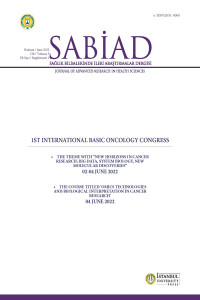INVESTIGATION OF CIRCULAR RNAs AS BIOMARKERS IN HEAD AND NECK CANCER CELLS AND THE EFFECTS OF RADIOTHERAPY ON CIRCULAR RNAs
Abstract
Objective: The head and neck squamous cell carcinoma (HNSCC) is the sixth most common type of cancer worldwide and the 5-year survival rate of patients is by 40-50 %. Radiotherapy is one of the important treatments for HNSCC. circRNAs, which are much more stabil than other RNAs because of their circular structure, have the potential to be a biomarker for all types of cancer. Therefore, the alterations of circRNAs expression in HNSCC cells and after irradiation was investigated. Methods: Pharyngeal cancer (Detroit-562) and healthy fibroblast (WI-38) cell lines were used. After appropriate irradiation dose for Detroit-562 cells was determined by colony formation assay, Detroit-562 cells were irradiated with 4 grays. The expression levels of 122 circRNA molecules in all groups were examined by RT-qPCR. The results were evaluated using CircNet and TCGA platforms. Results: In this study, 60 circRNAs were not expressed in any cell line, whereas 62 were found to be expressed in at least one of the groups, including irradiated Detroit-562, Detroit-562, and WI-38 cell lines. Among them, seven circRNAs were detected in all groups and expressed higher in Detroit-562 than two groups. Interestingly, these circRNAs were significantly decreased in irradiated group, exhibiting similar expression levels with healthy group. Bioinformatics analyses showed that the host genes of these circRNAs was also higher expressed in HNSCC tissue. Conclusions: Differential expression of circRNAs in cancers and changes with treatment revealed that they could be potential diagnostic and monitoring biomarkers in cancer. However, further studies need in this regard.
References
- Grozescu T, Popa F. Prostate cancer between prognosis and adequate/proper therapy. J Med Life. 2017;10(1):5-12
INVESTIGATION OF CIRCULAR RNAs AS BIOMARKERS IN HEAD AND NECK CANCER CELLS AND THE EFFECTS OF RADIOTHERAPY ON CIRCULAR RNAs
Abstract
Objective: The head and neck squamous cell carcinoma (HNSCC) is the sixth most common type of cancer worldwide and the 5-year survival rate of
patients is by 40-50 %. Radiotherapy is one of the important treatments for HNSCC. circRNAs, which are much more stabil than other RNAs because of
their circular structure, have the potential to be a biomarker for all types of cancer. Therefore, the alterations of circRNAs expression in HNSCC cells and
after irradiation was investigated.
Methods: Pharyngeal cancer (Detroit-562) and healthy fibroblast (WI-38) cell lines were used. After appropriate irradiation dose for Detroit-562 cells was
determined by colony formation assay, Detroit-562 cells were irradiated with 4 grays. The expression levels of 122 circRNA molecules in all groups were
examined by RT-qPCR. The results were evaluated using CircNet and TCGA platforms.
Results: In this study, 60 circRNAs were not expressed in any cell line, whereas 62 were found to be expressed in at least one of the groups, including
irradiated Detroit-562, Detroit-562, and WI-38 cell lines. Among them, seven circRNAs were detected in all groups and expressed higher in Detroit-562 than
two groups. Interestingly, these circRNAs were significantly decreased in irradiated group, exhibiting similar expression levels with healthy group.
Bioinformatics analyses showed that the host genes of these circRNAs was also higher expressed in HNSCC tissue.
Conclusions: Differential expression of circRNAs in cancers and changes with treatment revealed that they could be potential diagnostic and monitoring
biomarkers in cancer. However, further studies need in this regard.
References
- Grozescu T, Popa F. Prostate cancer between prognosis and adequate/proper therapy. J Med Life. 2017;10(1):5-12
Details
| Primary Language | English |
|---|---|
| Subjects | Clinical Sciences |
| Journal Section | Meeting Abstract |
| Authors | |
| Publication Date | August 9, 2022 |
| Submission Date | July 6, 2022 |
| Published in Issue | Year 2022 Volume: 5 Issue: S-1 |


